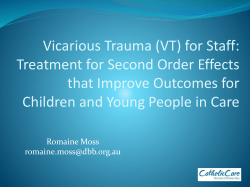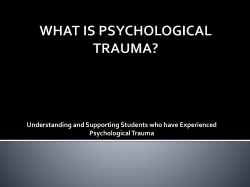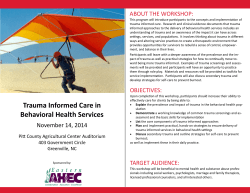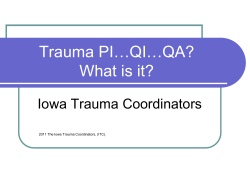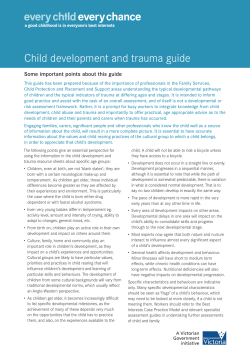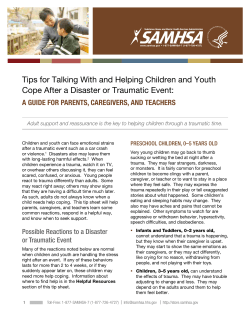
PART TWO:Essential Elements of Trauma-Informed Care and “How-To”
Handout 4 PART TWO:Essential Elements of Trauma-Informed Care and “How-To” From the National Child Traumatic Stress Network Trauma Toolkit www.nctsn.org Essential Elements – Why They Are Needed 1. Understand the impact trauma has on child’s behavior, development, and relationships. Traumatic events affect many aspects of the child’s life and can lead to secondary problems (e.g., difficulties in school and relationships, or health-related problems). These “secondary adversities” may mask symptoms of the underlying traumatic stress and interfere with a child’s recovery from the initial trauma. Traumatic events affect many aspects of the child’s life and can lead to secondary problems (e.g., difficulties in school and relationships, or health-related problems). These “secondary adversities” may mask symptoms of the underlying traumatic stress and interfere with a child’s recovery from the initial trauma. Secondary adversities can also lead to changes in the family system and must be addressed prior to or along with trauma-focused interventions. Understanding the Practical How-To of the Essential Elements for Parents 1. Understand the impact trauma has on child’s behavior, development, and relationships. Adapt, use developmental checklist Reevaluate where the child is coming from in terms of developmental domains Make a parenting plan on how to manage developmental delays with caseworkers/therapists Notes: Handout 4 2. Maximize the child’s sense of safety. Traumatic stress overwhelms a child’s sense of safety and can lead to a variety of survival strategies for coping. Safety implies both physical safety and psychological safety. A sense of safety is critical for functioning as well as physical and emotional growth. While inquiring about emotionally painful and difficult experiences and symptoms, workers must ensure that children are provided a psychologically safe setting 2. Maximize the child’s sense of safety. Give safety messages Be emotional container Recognize child’s hot spots Make it safe to talk Build trust through the power of yes Notes: 3. Assist children in reducing overwhelming emotion. Trauma can elicit such intense fear, anger, shame, and helplessness that the child feels overwhelmed. Overwhelming emotion may delay the development of age appropriate self-regulation. Emotions experienced prior to language development maybe be very real for the child but difficult to express or communicate verbally. Trauma may be “stored” in the body in the form of physical tension or health complaints 3. Assist children in reducing overwhelming emotion. Recognize, track trauma reminders (triggers) Understand the power of belief for all parties Tune In by managing emotional responses Remember the power of YES Notes: Handout 4 Essential Elements – Why They Are Needed 4. Help children to understand and modify overwhelming behaviors. Trauma can lead to serious disruptions in a child’s sense of safety, personal responsibility, and identity. Distorted connections between thoughts, feelings, and behaviors can disrupt encoding and processing of memory. Difficulties in communicating about the event may undermine a child’s confidence and social support. Understanding the Practical of How-To of the Essential Elements 4. Help children to understand and modify overwhelming behaviors. See below the surface of behaviors Remember there are beliefs driving behavior – decode the triangle Tune into your emotions and your child define and express his feelings Set an example of appropriate emotional expression Do not take behaviors personally 5. Support and promote positive and stable relationships in the 5. Support and promote positive and stable relationships in the life of the child. life of the child. Separation from an attachment figure, particularly under Ask a lot of questions of social workers/other foster traumatic and uncertain circumstances, is highly stressful parents - who are the important people for children. Encourage the child to talk about those significant people Familiar and positive figures—teachers, neighbors, Create a genogram with the child regarding his birth siblings, relatives—play an important role in supporting family children who have been exposed to trauma. Help the child build new connections with family, Minimizing disruptions in relationships and placements neighborhood, school, church and establishing permanency are critical for helping Notes: children form and maintain positive attachments Handout 4 Essential Elements – Why They Are Needed 6. Help the child develop a strength based understanding of his/her life story and to make new meaning of their trauma history and current experiences Traumatic events affect many aspects of the child’s life and can lead to secondary problems (e.g., difficulties in school and relationships, or health-related problems). These “secondary adversities” may mask symptoms of the underlying traumatic stress and interfere with a child’s recovery from the initial trauma. Secondary adversities can also lead to changes in the family system and must be addressed prior to or along with trauma-focused interventions. 7. Be an advocate/ support efforts to coordinate services with other agencies. Traumatized children and their families are often involved with multiple service systems. A team approach should be implements for documenting trauma history, exchanging information, coordinating assessments, and planning and delivering care with other professions and caregivers. Collaboration enables all helping professionals to view the child as a whole person, thus preventing potentially competing priorities. Understanding the Practical of How-To of the Essential Elements 6. Help the child develop a strength based understanding of his/her life story and to make new meaning of their trauma history and current experiences Be proactive in getting information about the child’s early life trauma, separations, moves and losses of significant people Respond calmly to new information about the child’s trauma history from professionals or the child himself Follow the Ten Principles of Talking to Your Child About His Past Notes: 7. Be an advocate/ support efforts to coordinate services with other agencies Others may not understand the impact of trauma on a child Others (teachers, coaches, etc. may not know strategies for helping others a child overwhelming emotions and problem behaviors Others may not approach a child from a strength based perspective. Notes: Handout 4 8. Promote and support trauma informed focus assessment and 8. Promote and support trauma informed focus assessment and treatment. treatment. No one size fits all when it comes to treatments for Thorough assessment can identify a child’s reactions and children how his or her behaviors are connected to the traumatic The family will be given a proposed treatment plan which experience. will include involvement with the caregivers – not just the Thorough assessment can also predict potential risk child behaviors and identify interventions that will ultimately There are no quick fixes reduce risk. Beware of treatments that use rebirthing or holding Child welfare workers can use assessment results to therapies determine the need for referral to appropriate traumaNotes: specific mental health care or further comprehensive trauma assessment 9. The family’s understanding of the need for parental self-care Parents may empathize with victims; feelings of helplessness, anger, and fear are common. Parents who have histories of childhood trauma, might be at particular risk for experiencing reactions Parents who find themselves isolated from family and friends are at risk 9. The family’s understanding of the need for parental self-care and willingness, ability and understanding in evaluating their own personal response to the child’s behavior and unique needs: Know the warning signs Ask for help Make a family care plan
© Copyright 2025


